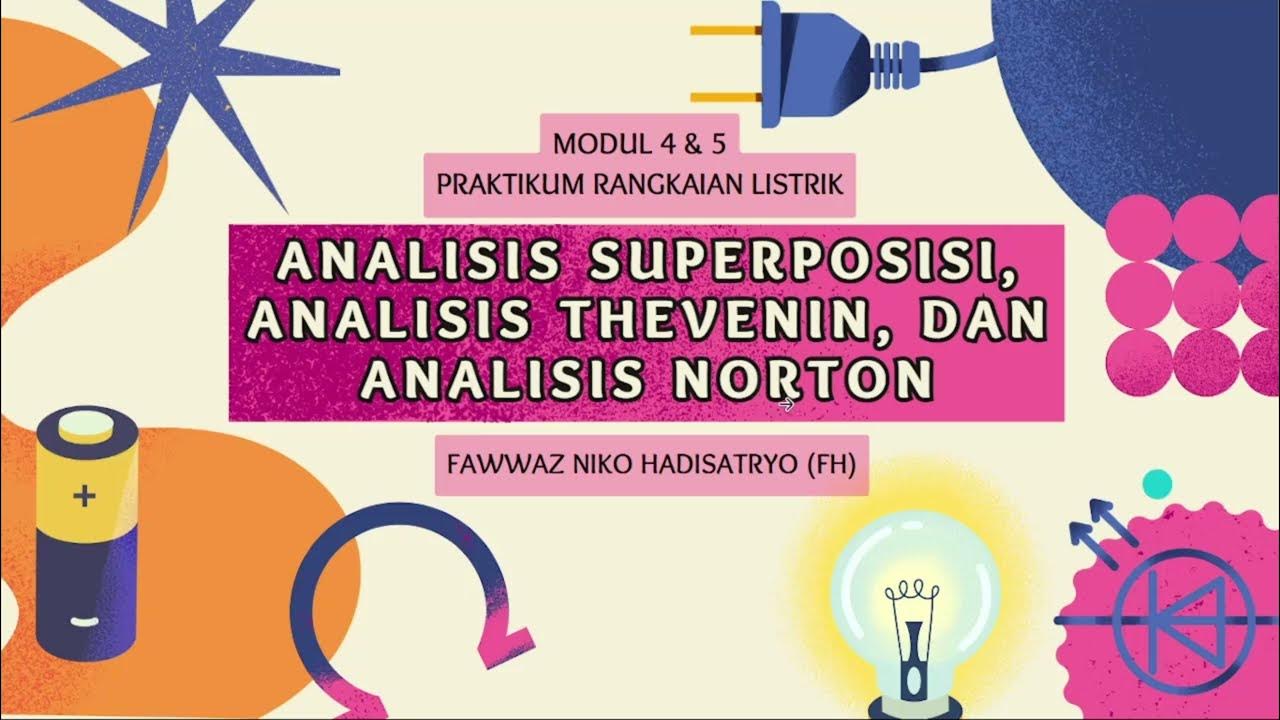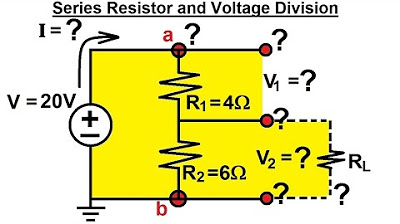TEI3B2 - Elektronika B - Analisis DC BJT - Voltage Divider
Summary
TLDRThis video explains the analysis of a voltage divider circuit with a focus on transistor-based circuits. The presenter walks through calculating various parameters such as base voltage (VBB), base current (IB), emitter current (IE), collector current (IC), and voltage across the collector-emitter junction (VCE). The importance of the two resistors in the voltage divider, the role of capacitors, and the use of Ohm’s law and loop analysis to solve for unknowns are covered in detail. The presenter also demonstrates how to handle the circuit in DC analysis and how to find key voltages and currents in the circuit.
Takeaways
- 😀 Voltage divider circuits include two resistors at the base of the transistor, differing from common emitter or fixed bias configurations.
- 😀 Capacitors in the circuit are open-circuited during DC analysis, effectively disappearing from the circuit.
- 😀 The base voltage (Vb) is determined using voltage division between two resistors connected to Vcc, yielding a value of 2V for this example.
- 😀 To find the equivalent resistance (Rb) entering the base, the resistors are treated as being in parallel after deactivating the voltage source.
- 😀 The resulting value of Rb is 3.55kΩ after combining the resistors in parallel.
- 😀 Once the voltage at the base (Vbb) is known, the circuit is analyzed by applying Kirchhoff's Voltage Law (KVL) to solve for IB, IE, IC, and VCE.
- 😀 For base-emitter voltage (Vbe), a value of 0.7V is assumed, which helps calculate the transistor currents (IB, IC, IE).
- 😀 The collector current (IC) is calculated as the product of the current gain (β) and base current (IB), where β is given as 100.
- 😀 The loop analysis is used to calculate VCE, considering the voltage drops across components like the collector resistor (RC) and emitter resistor (RE).
- 😀 Voltage at the collector (VC) is calculated using the loop from the collector to ground, while the emitter voltage (VE) is calculated based on the emitter loop, resulting in a VCE of around 12.34V.
Q & A
What is the main topic discussed in the transcript?
-The main topic discussed is the voltage divider circuit, with an emphasis on analyzing the DC behavior of a transistor circuit involving two resistors and their configuration in a voltage divider setup.
What differentiates a voltage divider from a fixed bias or common emitter configuration?
-In the voltage divider configuration, two resistors are connected to the base of the transistor, with one resistor connected to the base and the other to VCC. This differs from the fixed bias or common emitter configurations, where only one resistor typically connects to the base.
What happens to the capacitors in the analysis process?
-The capacitors in the circuit are treated as open circuits during the DC analysis. This means that all capacitors are effectively removed from the circuit, simplifying the analysis.
How is the base voltage (Vbb) calculated in this setup?
-The base voltage (Vbb) is calculated using a voltage divider formula. The voltage is divided between two resistors (R2 and R1), and the resulting voltage is multiplied by the supply voltage (22V in this case). The formula used is: Vbb = (R2 / (R1 + R2)) * Vcc.
How is the base resistance (RB) determined in this circuit?
-The base resistance (RB) is determined by finding the parallel resistance of the two resistors (R1 and R2) that are connected to the base. This is done by deactivating all voltage sources and short-circuiting them, which allows for the calculation of the equivalent resistance using parallel resistance formulas.
What role does the transistor's beta (β) play in the analysis?
-The transistor's beta (β) plays a key role in determining the relationship between the base current (IB) and the collector current (IC). The collector current is calculated as IC = β * IB, and the emitter current (IE) is related to IB by IE = (β + 1) * IB.
How is the emitter current (IE) calculated?
-The emitter current (IE) is calculated using the formula IE = (β + 1) * IB, where β is the current gain of the transistor and IB is the base current.
What is the significance of Vbe in the analysis?
-Vbe (the base-emitter voltage) is typically 0.7V when the transistor is active. This voltage drop is used to determine the voltage at the emitter (Ve) and is a key parameter when analyzing the transistor's behavior in the circuit.
How is the collector voltage (VC) determined in the analysis?
-The collector voltage (VC) is determined by analyzing the loop from the collector to ground, considering the voltage drops across the collector resistor (RC) and the collector-emitter voltage (VCE). The loop equation takes into account the direction of current flow and the associated voltage drops.
What is the final result for the voltage across the collector-emitter (VCE)?
-The final value for the voltage across the collector-emitter (VCE) is calculated to be around 12.34V, based on the analysis using Kirchhoff's voltage law (KVL) and the known parameters of the circuit.
Outlines

This section is available to paid users only. Please upgrade to access this part.
Upgrade NowMindmap

This section is available to paid users only. Please upgrade to access this part.
Upgrade NowKeywords

This section is available to paid users only. Please upgrade to access this part.
Upgrade NowHighlights

This section is available to paid users only. Please upgrade to access this part.
Upgrade NowTranscripts

This section is available to paid users only. Please upgrade to access this part.
Upgrade NowBrowse More Related Video

Video Pembelajaran Modul 4 & 5 Praktikum Rangkaian Listrik 2024/2025 (FH)

Electrical Engineering: Basic Laws (13 of 31) Series Resistors and Voltage Division

Dasar Teknik Elektro - Seri Pembagi Tegangan

Análise de Circuitos - Aula 02

Class AB Output Stage: Biasing Using a VBE Multiplier

Penjelasan Transistor NPN dan PNP – Beserta contoh rangkaiannya
5.0 / 5 (0 votes)